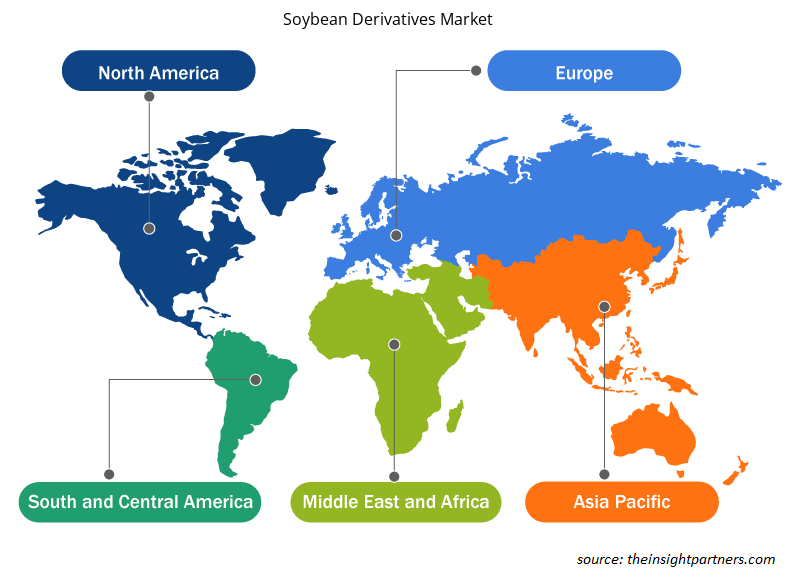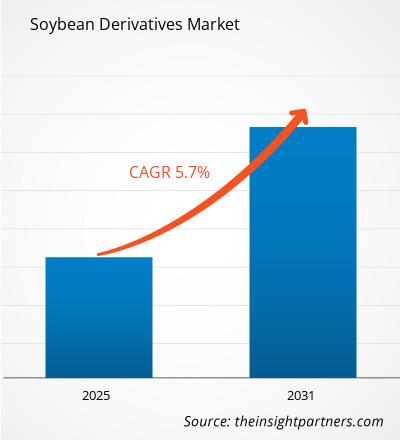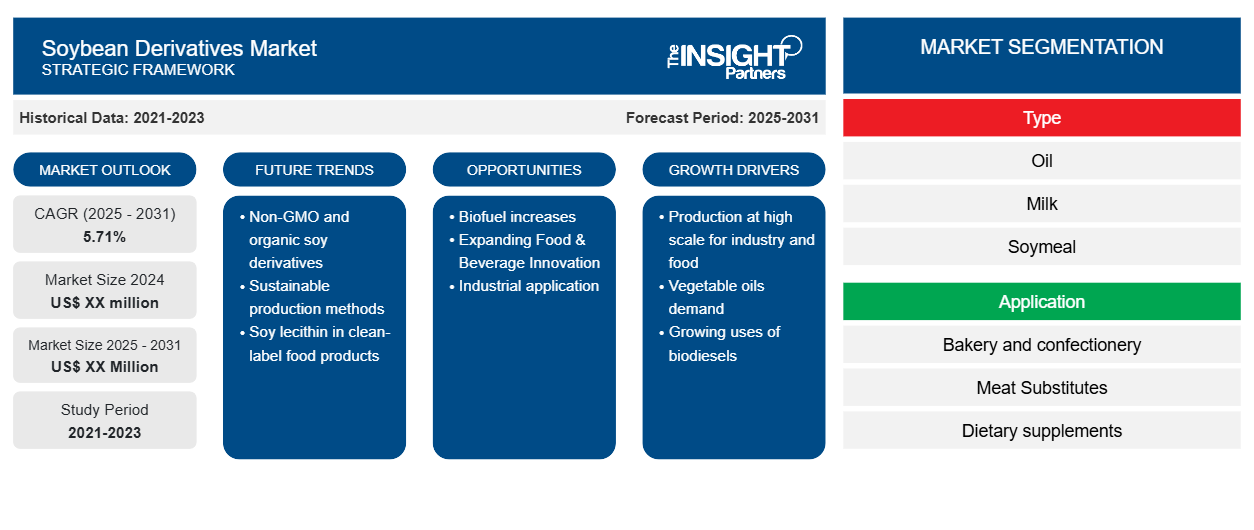预计 2024 年至 2031 年期间大豆衍生品市场的复合年增长率为 5.71%,市场规模将从 2024 年的 XX 百万美元扩大到 2031 年的 XX 百万美元。
大豆衍生品市场按类型分为以下子部分:油、牛奶、豆粕、卵磷脂、豆腐、组织化大豆蛋白 (TSP)、蛋白质和其他。它进一步根据应用进行了分析,即烘焙和糖果、肉类替代品、膳食补充剂、饮料、甜味和咸味小吃和其他。全球分析按区域和主要国家细分。上述细分分析的市场评估以美元表示。
报告目的
The Insight Partners 的《大豆衍生品市场》报告旨在描述当前形势和未来增长、主要驱动因素、挑战和机遇。这将为各种商业利益相关者提供见解,例如:
- 技术提供商/制造商:了解不断变化的市场动态并了解潜在的增长机会,从而能够做出明智的战略决策。
- 投资者:对市场增长率、市场财务预测以及整个价值链中存在的机会进行全面的趋势分析。
- 监管机构:监管市场政策和警察活动,旨在最大限度地减少滥用行为,维护投资者的信任和信心,维护市场的完整性和稳定性。
大豆衍生品市场细分
类型
- 油
- 牛奶
- 豆粕
- 卵磷脂
- 豆腐
- 大豆组织蛋白
- 蛋白质
- 其他的
应用
- 面包和糖果
- 肉类替代品
- 膳食补充剂
- 饮料
- 甜味和咸味小吃
- 其他的
定制此报告以满足您的需求
您可以免费定制任何报告,包括本报告的部分内容、国家级分析、Excel 数据包,以及为初创企业和大学提供优惠和折扣
- 获取此报告的关键市场趋势。这个免费样品将包括数据分析,从市场趋势到估计和预测。
大豆衍生品市场增长动力
- 大规模生产用于工业和食品:大豆衍生物包括油、卵磷脂和面粉。它们被广泛应用于各种产品,包括食用油和乳化剂等食品、动物饲料以及生物柴油和塑料等工业产品。
- 植物油需求:大豆油是世界上使用最广泛的食用油,因为它价格便宜且缺乏味道。
- 生物柴油的用途日益广泛:大豆基生物柴油在可持续可再生能源领域处于领先地位。
大豆衍生品市场未来趋势
- 非转基因和有机大豆衍生物:人们对食品应用的兴趣日益浓厚,消费者更喜欢非转基因或有机大豆衍生物,尤其是用于生产油、卵磷脂和面粉时。
- 可持续生产方法:对于食品和工业领域来说,可持续和道德采购是当今的重中之重。这包括经过认证的可持续大豆。
- 清洁标签食品中的大豆卵磷脂:大豆卵磷脂越来越多地被大规模应用于清洁标签食品系统中的天然乳化剂,主要用于糖果和烘焙应用。
大豆衍生品市场机会
- 生物燃料增加:随着对可再生能源的考虑越来越多,对大豆生物柴油替代来源的需求逐年增加。
- 扩大食品和饮料创新:大豆衍生物必须用于新的食品和饮料创新,例如功能性饮料和健康零食。
- 工业应用:出于可持续生产的目的,大豆衍生物越来越多地用于各种工业应用,其中包括可生物降解的塑料、涂料和化妆品等。
大豆衍生品市场区域洞察
Insight Partners 的分析师已详尽解释了预测期内影响大豆衍生品市场的区域趋势和因素。本节还讨论了北美、欧洲、亚太地区、中东和非洲以及南美和中美洲的大豆衍生品市场细分和地理位置。

- 获取大豆衍生品市场的区域特定数据
大豆衍生品市场报告范围
| 报告属性 | 细节 |
|---|---|
| 2024 年的市场规模 | XX 百万美元 |
| 2031 年市场规模 | XX 百万美元 |
| 全球复合年增长率(2025 - 2031) | 5.71% |
| 史料 | 2021-2023 |
| 预测期 | 2025-2031 |
| 涵盖的领域 | 按类型
|
| 覆盖地区和国家 | 北美
|
| 市场领导者和主要公司简介 |
|
大豆衍生品市场参与者密度:了解其对业务动态的影响
大豆衍生品市场正在快速增长,这得益于终端用户需求的不断增长,而这些需求又源于消费者偏好的不断变化、技术进步以及对产品优势的认识不断提高等因素。随着需求的增加,企业正在扩大其产品范围,进行创新以满足消费者的需求,并利用新兴趋势,从而进一步推动市场增长。
市场参与者密度是指在特定市场或行业内运营的企业或公司的分布情况。它表明在给定市场空间中,相对于其规模或总市场价值,有多少竞争对手(市场参与者)存在。
在大豆衍生品市场运营的主要公司有:
- 邦吉有限公司
- 阿彻丹尼尔斯米德兰公司
- 路易达孚商品有限公司
- 嘉吉公司
- 丰益国际有限公司
免责声明:上面列出的公司没有按照任何特定顺序排列。

- 了解大豆衍生品市场的主要参与者概况
主要卖点
- 全面覆盖:报告全面涵盖了大豆衍生品市场的产品、服务、类型和最终用户的分析,提供了整体概况。
- 专家分析:报告基于对行业专家和分析师的深入了解而编写。
- 最新信息:该报告涵盖了最新信息和数据趋势,确保了其与业务的相关性。
- 定制选项:此报告可以定制以满足特定客户要求并恰当地适应业务策略。
因此,大豆衍生品市场研究报告有助于引领解读和了解行业情景和增长前景。尽管可能存在一些合理的担忧,但本报告的总体优势往往大于劣势。
- 历史分析(2 年)、基准年、预测(7 年)及复合年增长率
- PEST和SWOT分析
- 市场规模、价值/数量 - 全球、区域、国家
- 行业和竞争格局
- Excel 数据集
近期报告
客户评价
购买理由
- 明智的决策
- 了解市场动态
- 竞争分析
- 客户洞察
- 市场预测
- 风险规避
- 战略规划
- 投资论证
- 识别新兴市场
- 优化营销策略
- 提升运营效率
- 顺应监管趋势





















 获取免费样品 - 大豆衍生品市场
获取免费样品 - 大豆衍生品市场